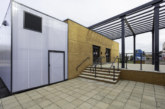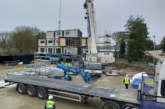Andy Smith, Head of Business Development at Caledonian, looks at the reasons modular and offsite construction is providing a way forward for the education sector.
Following the Government’s ongoing commitment to favour offsite manufacturing on all publicly funded construction projects going forward, the benefits (including shorter timescales, quality manufacturing, sustainability and improved health and safety on site) have become more widely understood.
There was good reason why the Government stated in favour of offsite. Last year, about one in five families in England failed to gain a place at their first choice school, with the rate rising above 40% in several London boroughs. It is estimated that by 2022, around a third of councils will have a shortage of places for nearly 60,000 pupils. That figure rises to nearly half of all local authorities in England by September 2024, when more than 120,000 young people are ‘at risk of no place’ if new schools are not built.
Overcrowding remains an issue and LEA’s need to extend existing establishments and invest in new facilities to accommodate the increasing number of pupils. However, with limited funds available, careful consideration must be made about the cost effectiveness, timescales and build quality of all construction methods in order that LEA’s achieve value for money.
A SMART solution
In comparison to traditional construction, offsite techniques enable more than 80 – 90% of the work to be completed in a factory, which is a quality controlled environment unaffected by the weather. This reduces the likelihood of the build being put on hold due to adverse weather conditions. Individual classrooms through to whole schools can be completed using offsite and within the school holiday window, meaning significantly less risk-assessed people on or around the site.
Manufactured offsite and then assembled onsite also creates a safer workplace, because it is a more controlled environment that requires less need for working at height. With transportation and trade reduced there is less traffic and noise impact on both the school and the local community. Modular is more economical and better for the environment, too, as there is a dramatic reduction in waste compared to traditional build methods.
Modular schools
We were recently appointed as Lead Designer and Principal Contractor for Haygrove School in Bridgwater and The Sir Frederick Gibberd College in Essex under Department for Education (DfE) frameworks. Our strategy on both projects is to maximise the extent of onsite groundworks prior to the modules arriving on site, which are delivered and installed with final decorations, floor coverings and furniture completed at our Newark based manufacturing facility. This significantly reduces onsite works and disruption to the school and local community and maximises quality control and efficiency, reducing the overall project timescales.
The new £29m secondary school at the Sir Frederick Gibberd College will comprise a 1,200 place facility built over three storeys including a school hall, dining hall, drama studio and a 500 place sixth form teaching area as well as sports facilities and all associated external works and sports pitches. The design incorporates concrete floors and, being a component-based system, allows greater flexibility in design whilst delivering a DfE compliant solution as well as all the efficiency and time saving benefits of a modular build.

Work being undertaken at Haygrove School will involve utilising Caledonian’s component based education solution to replace the main building with modern and efficient offsite manufactured teaching environments. The construction work will be undertaken while the school remains open with works carefully planned to ensure minimal disruption to both the teaching timetable and local community.
The three-storey building will consist of classrooms, double-height hall and studio spaces, offices, kitchen and associated rooms for educational purposes, along with enabling, groundwork’s and external works. Both schools incorporate factory installed concrete floors to deliver an acoustically compliant, comfortable, safe and durable environment.
As part of a consultative approach, the design of SFGC and Haygrove School were informed by standards supplied by the Department for Education and developed through a series of engagement meetings with the schools and stakeholders. We worked closely with the DfE and the schools, as we do on all our education projects, to deliver modern, efficient teaching spaces that will open further opportunities for young people in the area.
£3bn education Framework
In January this year, working with Stride Treglown Architects, we were selected as one of five companies to deliver a £2bn programme of offsite built secondary schools and blocks, for the Department of Education (DFE) under Lot 1 of the Modern Methods of Construction Framework. The other smaller scale project, Lot 2, will deliver a £1bn programme of offsite built primary school schemes and secondary blocks.
Established by the DfE to build on the success of recent modular procurements, this major framework supports a wider government move towards modern methods of construction as a preference for new-build projects and reinforces the desire of the DfE to continue the commitment to Modern Methods of Construction in the delivery of education projects.
The answer to shortage of places
Our recent portfolio of projects within the education sector and success in securing first place on several major Frameworks are testament to the fact that offsite and modular construction is the way forward for schools including primary, secondary and higher education, in line with the Government’s push. With many other establishments throughout the UK choosing modular solutions, we expect that offsite construction will not only continue to gain popularity but will become the preferred option.
Header image: Haygrove School is utilising Caledonian’s component based education solution to replace the main building.









